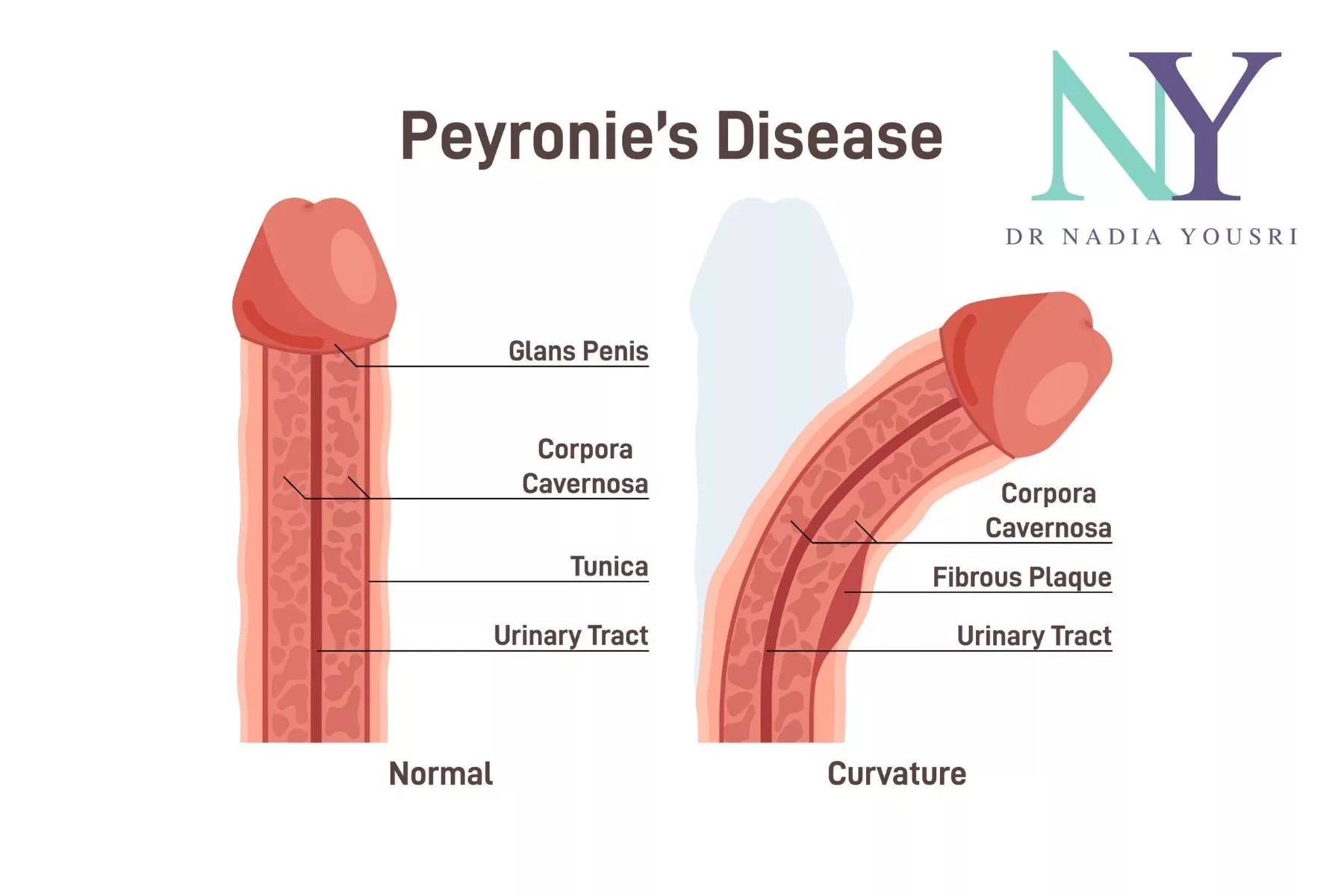What is Peyronie’s Disease?
Peyronie’s Disease is a medical condition characterised by the development of fibrous scar tissue inside the penis, leading to curved, painful erections. This curvature is due to plaque formation within the penile tissue, specifically in the Tunica Albuginea layer. While the exact cause of Peyronie’s Disease is not always obvious but is it’s often linked to micro-injuries, genetic predispositions, and certain connective tissue disorders. Men over 30 and those with a history of diabetes or prostate surgery are at increased risk. Understanding this condition is important in the quest for effective treatment and management.
Impact of Peyronie’s Disease on Quality of Life
Physical Complications
The physical implications of Peyronie’s Disease extend beyond the noticeable curvature of the penis. Patients may experience painful erections, making sexual intercourse challenging or impossible. The disease can also lead to erectile dysfunction, significantly impacting a man’s sexual health and reproductive capabilities. These physical complications necessitate a comprehensive treatment approach, focusing on symptom relief and functional restoration.
Psychological and Emotional Effects
Peyronie’s Disease can have profound psychological and emotional effects. The visible changes and discomfort can lead to diminished self-esteem, anxiety, and, in severe cases, clinical depression. This emotional toll can strain relationships, as partners may struggle to understand and cope with the condition’s impact. Recognising and addressing these psychological aspects is as important as treating the physical symptoms.
Treatment Options for Peyronie’s Disease
If you’re struggling with Peyronie’s Disease, know that you’re not alone and multiple treatment avenues are available. Dr Nadia Yousri, with her vast experience both as a consultant and at her renowned Harley Street clinic, has successfully treated hundreds of patients. There’s no need to suffer in silence.
Understanding Peyronie’s Disease
Peyronie’s Disease manifests as a curvature or bend in the penis, flaccid or erect. Penis curves occur because scar tissue forms, known as plaque, that forms within the penile tissue in the Tunica Albuginea layer. This plaque tugs at the surrounding tissues, leading to painful erections and making sexual intercourse challenging. It is also found in patients with scar tissue caused by trauma or patients suffering from certain connective tissue disorders. Those with a predisposition to excessive scar tissue formation can also suffer from Peyronie’s disease.
The Tunica Albuginea
The Tunica Albuginea is a testament to the body’s intricate design, ensuring functionality while offering protection. It’s a fibrous tissue layer that, while not commonly discussed, holds significant importance in reproductive health and sexual penetration. The Tunica Albuginea layer comprises a dense, fibrous sheath that encapsulates the corpora cavernosa, two cylindrical structures running the length of the penis. This sheath is not just a protective layer; it’s integral to the erectile function.
When a man becomes aroused, blood flows into the corpora cavernosa, causing them to expand. The Tunica Albuginea, being elastic, stretches during this process, allowing the penis to become erect. Post arousal, it contracts, aiding in the return to its flaccid state.
When should I seek help for Pernonies disease?
You should seek help for Peyronies if the pain or curvature doesn’t improve within three months from the date you first notice it.
Symptoms of Peyronie’s Disease
Acute Phase (up to 18 months):
- Formation of the plaque.
- Pain in the penis, both at rest and during an erection.
- Discomfort during sex
- Noticeable curvature in the penis, even when flaccid.
- Erectile function issues
Chronic Phase (post plaque formation):
- Reduced pain but persistent curvature.
- Thickening of the plaque, possibly leading to lumps or indentations.
- Worsening Erectile Dysfunction.
Causes & Predisposing Factors
While 3-9% of adult males experience Peyronie’s Disease, certain factors increase the risk:
- Micro injuries from vigorous activities or misuse of mechanical stretching devices.
- Genetic predisposition to tissue or autoimmune disorders like Dupuytren’s, Systemic lupus erythematosus (SLE), and Scleroderma.
- Men over 30.
- Diabetes-induced ED or post-prostatectomy.
- Family history of Peyronie’s Disease.
- Psychological factors like stress, depression, or anxiety about sexual performance.
In many cases, the exact cause remains unidentified. However, medical history, physical exam to diagnose Peyronie’s disease and assessment can sometimes pinpoint a cause, such as Dupuytren’s contracture. An ultrasound can help locate and measure the plaque.
Non-Surgical Treatments
While the Peyronie disease itself has historically been treated surgically, several non-surgical options have emerged in clinical trials for Peyronies disease treatment.
- Plasma Injections (P-Shot®): A natural treatment using Platelet Rich Plasma injections. The success rate varies based on several factors, including the patient’s general health and the plaque’s thickness.
- Shockwave Therapy: Uses low-intensity sound waves to reduce pain and plaque size. Dr Nadia crafts individualised treatment plans after a thorough assessment.
- Other Options: These include Collagenase penile injections, Verapamil (Originally used to treat high blood pressure), Interferon-alpha 2b, and more. Note: No oral medicines have proven effective in treating penile curvature so far.
Surgical Techniques
Dr Nadia specialises in NON-surgical treatments to treat Peyronie’s disease. However, for those considering surgery to straighten the penis consulting with an Uro-surgeon is advised. Common surgical methods include grafting, plication, and penile implants. It is vital to understand the potential risks and benefits of each method. Surgical techniques are usually reserved for more severe cases of curvature when treating Peyronie’s disease.
Dr. Nadia Yousri Clinic’s Approach to Peyronie’s Disease
Personalised Treatment Plans
At Dr. Nadia Yousri’s Clinic, we understand only too well that each case of Peyronie’s Disease is unique. Our approach is to create personalised treatment plans tailored to each patient’s exact needs. We consider factors like the severity of the curvature, the presence of pain, and the patient’s overall health. This individualised strategy ensures that each patient receives the most effective and appropriate treatment for their condition.
Advanced Techniques and Technologies
We employ advanced techniques and technologies to treat Peyronie’s Disease. Our clinic utilises non-surgical options like Plasma Injections (P-Shot®) and Shockwave Therapy, which have shown promising results in clinical trials. These treatments aim to reduce pain, decrease plaque size, and improve erectile function, offering patients a non-invasive alternative to traditional surgical methods.
Psychological Impact on Men and Relationships Due to Peyronie’s Disease
Peyronie’s Disease, while primarily a physical condition, often casts a profound psychological shadow over those affected. For many men, the visible change and severe curvature can lead to diminished self-confidence, feelings of inadequacy, and even lead to clinical depression in certain cases. The disease can compromise their masculinity and identity, making them overly self-conscious about intimate encounters. Relationships, too, bear the brunt of this emotional distress. Partners may grapple with understanding the depth of the distress and may feel helpless or sidelined. It is paramount that both parties recognise the profound psychological impact and potentially seek counselling or therapy as a means of navigating these emotional challenges, if they arise.
Yes, trauma or injury to the penis is believed to be a primary cause, leading to scar tissue or plaque formation within the penile tissue.
In some cases, Peyronie’s disease may improve without treatment, but often medical intervention is required.
It might worsen. Peyronie’s disease can lead to a significant bend and pain in the penis and make sexual intercourse difficult or impossible. It can also exacerbate erectile dysfunction.
Peyronie’s disease is more common in men over 30.
Peyronie’s disease is primarily diagnosed through a physical examination, and sometimes an ultrasound may be used.
Treatments range from non-surgical methods like Plasma Injections and Shockwave Therapy to surgical techniques such as grafting and plication.
Yes, Peyronie’s disease can lead to painful erections, a significant curvature in the penis, and can result in erectile dysfunction.
Avoiding penile trauma and being aware of one’s body can help reduce the risk and aid in early detection and treatment.
Peyronie’s disease affects 3-9% of adult males.
Yes, a naturally curved penis is benign and doesn’t cause pain, whereas Peyronie’s disease results from scar tissue formation and often leads to pain, especially during erections.
References:
– Article on Shockwave Therapy performed by Dr. Nadia Yousri, published in Daily Mail on September 14th 2020. “Shocking treatment to perk up a man’s flagging lovelife: Can erectile dysfunction really be cured with soundwaves?”.
–Conservative treatment of Peyronie’s disease: colchicine vs. colchicine plus vitamin E. J R Cortés-González 1, S Glina. Actas Urol Esp. 2010 May;34(5):444-9
Cakan M, Demirel F, Aldemir M, Altug U. Arch Androl. 2006 Jan-Feb;52(1):21-7.
Toscano L Jr, Rezende MV, Mello LF, Paulillo D, Glina S. Int Braz J Urol. 2016 Sep-Oct;42(5):1005-1009
–Review of current nonsurgical management of Peyronie’s disease.
Levine LA. Int J Impot Res. 2003 Oct;15 Suppl 5:S113-20
–Platelet-Rich Plasma Therapy for Male Sexual Dysfunction: Myth or Reality?
Epifanova MV, Gvasalia BR, Durashov MA, Artemenko SA. Sex Med Rev. 2020 Jan;8(1):106-113
Porst H. Sex Med Rev. 2021 Jan;9(1):93-122
Also, checkout:
Updated date: August 2023

